
When looking at the famously mis-titled "Vision for High Speed Rail in America" map trotted out last year, showing those of state-planned High Speed Rail corridors that have already applied for and received official designation as High Speed Rail corridors ... there are ghosts on that map.
The Ghosts of Trains Past, also known as the Amtrak long distance routes.
As discussed on November 8th of last year in Rescuing the Innocent Amtrak Numbers from SubsidyScope, some of these ghosts are healthier than others. One of the ones in the most dire shape is the Cardinal, responsible for the only line on that map that enters either West Virgnia or eastern Kentucky.
Why it does so badly, and how it might be fixed up a bit, after the fold.
---[ Discussion at Agent Orange and elsewhere around the web ]---
Conventional Long Distance Rail Aint Easy
 When tossing aside the fatally flawed SubsidyScope treatment of capital depreciation ... and I am still eagerly awaiting their consideration of the subsidies to road and air transport that uses the same approach to capital depreciation ... most long haul Amtrak routes have similar financial performance. If one says, "long haul Amtrak routes recover between 40% and 50% of their operating costs from fare revenue", that would cover ten of fifteen services:
When tossing aside the fatally flawed SubsidyScope treatment of capital depreciation ... and I am still eagerly awaiting their consideration of the subsidies to road and air transport that uses the same approach to capital depreciation ... most long haul Amtrak routes have similar financial performance. If one says, "long haul Amtrak routes recover between 40% and 50% of their operating costs from fare revenue", that would cover ten of fifteen services: - from the Southwest Chief (IL/CA) and City of New Orleans (IL/LA) at 49%,
- through the Silver Meteor (NY/FL), Capital Ltd (DC/IL), Coast Starlight (WA/CA), Crescent (NY/LA), Texas Eagle (IL/TX), California Zephyr (IL/CA),
- to the Silver Star (NY/FL) and Lakeshore Ltd (MA|NY/IL) at 41%.
There are three that did better in the year that SubsidyScope considered: the specialty Auto Train between Virginia and Florida, at 85%, the Empire Builder from Illinois to Washington and Oregon at 61%, and the Palmetto from New York to Georgia at 55%.
And two that did worse: the Cardinal at 34%, and the Sunset Ltd from Louisiana to California at 23%.
This is not a diary about "fixing long distance rail". Whether 40% to 50% is a reasonable return given the other benefits that long distance rail may provide is not something I am fixing to consider tonight.
Instead, considering the norm of 41% to 49% ... the Cardinal falls short. That means that if the long knives come out, its neck is not far from the chopping block. And that is true even if in fact the average long haul route does provide twice as many external benefits as passenger benefits, and so it is true even if the Cardinal breaks even in an economic sense.
And its worse than that. The Cardinal is a route that runs three times a week in each direction. The final leg of its route to Chicago and first leg of its route from Chicago is "the Hoosier State", which runs as an independent short corridor routes the rest of the week.
And the Hoosier State is in even more dire straits ... where 9 of 26 regional corridor routes have operating cost recovery between 64% and 79%; 20 of 26 have operating cost recovery above 50%; and 25 out of 26 have operating cost recover above 30% ...
... the Hoosier State has operating cost recovery of 15%.
I have seen a comment to the effect that when Senator Byrd is no longer there to defend it, the Cardinal is going to be shut down. While I have no idea how accurate that comment is - it is certainly plausible.
Oh. My. God. How does it hit 34%?
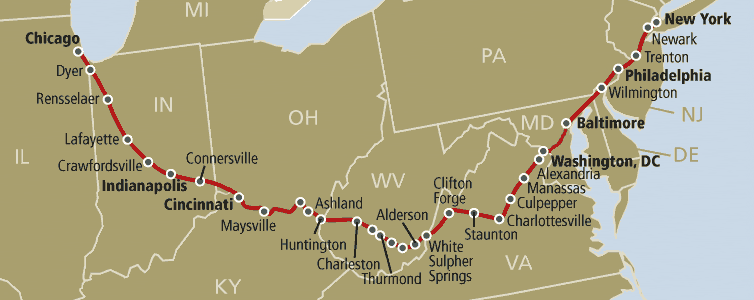
And then you look at the schedule of the Cardinal, and wonder how it gets enough fares to cover 34% of its operating costs.
Consider it as a train to get to Chicago. Westbound, it is scheduled to arrive in Chicago at 10:35 in the morning, after leaving Indianapolis at 6:30am - that is the daily Hoosier State schedule. It is scheduled to arrive in Indianapolis at 4:44am, after leaving Cincinnati at 1:10am. It traveled through Kentucky between 10pm and midnight, and through West Virginia between 6:30pm and 9:35pm, leaving the capital of Charleston WV at 8:10pm.
Scanning up the timetable, the train got into southern West Virginia from western Virginia, and to there from Washington, DC. And that is the real surprise: this route which spends so much of its time heading up toward Chicago from the east by southeast ... originates in New York. Of course, nobody would take it from New York to Chicago, even if they were determined to rider the train, since its the slowest of the New York to Chicago trains.
The problem is, if you stop the train and turn it around at Washington DC, there does not seem to be a lot that is gained ... because the total route end to end is 23:25 from DC to Chicago, and 24:10 from Chicago to DC. So when taking turn-over operations and the schedule slack to cope with the inevitable delays, its hard to tailor the timetable to provide appropriate return trip schedules without losing quite a lot of time sitting idle.
As to how it hits 34%, that could well be on that part between New York and western Virginia ... which is part of the reason why the schedule timing is so poor for the majority of the route.
Except, with a little imagination ... it might be possible to fix the schedule up.
Fixing the Cardinal
 The balance of this diary is done on a simple rule. I transport the current scheduled times between cities from existing Amtrak scheduled routes to the route that I am building here. Sure, in the Sunday Train, I've spent more than a little time writing about High Speed Rail ... but here, I am sticking to the conventional rail Amtrak.
The balance of this diary is done on a simple rule. I transport the current scheduled times between cities from existing Amtrak scheduled routes to the route that I am building here. Sure, in the Sunday Train, I've spent more than a little time writing about High Speed Rail ... but here, I am sticking to the conventional rail Amtrak.That does not guarantee that these timetables are either feasible or, if feasible, exact. I have no inside information on rail system bottlenecks, and so this should be seen as nothing but a rough sketch. However, its a rough sketch draw with the brush of existing scheduled services.
Start out by breaking the Hoosier State free of the Cardinal. It might run, for instance, down from Chicago at 7:30am, and return to Chicago at 7:00pm, if that is what transport studies indicates is the most appealing schedule. It might make one round trip and one single trip, providing different MWF and TRS schedules. It might run from Chicago through Indianapolis to Cincinnati and back each day. If running past Miami of Ohio in the middle of the day makes it look promising, it could add a Miami University station. Whatever looks to be the most attractive to the most passengers riding the train for the longest trips.
Now, don't think about the Cardinal route as a New York route, think about it as a Chicago route. Chicago to Indianapolis is covered. Chicago to Cincinnati through to DC is a much longer ride. And the best way to cut time out of the ride is to make it a sleeper service.
So leave Chicago at 10pm. The train runs through Indianapolis between 4am and 5am, then reached Cincinnati at 7:45am. It gets to Charleston, WV about 12:30pm, starts passing through western Virgnia around 4:30pm, and hits Washington around 10:10pm.
 OK, now, we have a train arriving in DC at about 10:10pm ... why not make it a night train as well. I'll have it continue around 11pm heading up toward Pittsburgh, along the Capital Corridor route. It gets to Pittsburgh about 7am, Cleveland about 10am, Toledo 12:30pm, and gets to Chicago about 4pm. That gives it six hours to get ready to start the loop all over again.
OK, now, we have a train arriving in DC at about 10:10pm ... why not make it a night train as well. I'll have it continue around 11pm heading up toward Pittsburgh, along the Capital Corridor route. It gets to Pittsburgh about 7am, Cleveland about 10am, Toledo 12:30pm, and gets to Chicago about 4pm. That gives it six hours to get ready to start the loop all over again.The key to the night train scheduling is to make sure that the reverse trip is a similar night train. So a second train runs the reverse route, leaving Chicago at about noon, getting to Cleveland about 7:15pm and Pittsburgh 10:40pm, then DC at 6:30 the next morning. Leave DC at 8:30 to arrive at Charleston WV 5:30pm, Cincinnati at 10:30pm, and Chicago at about 7:55 the next morning.
Now, this is still a three-times-a-week train, but now the overnight service into Chicago arrives before the Start of Business, getting maximum value from the sleeper train. The same thing happens heading southwest into DC on the Cleveland/Pittsburgh leg.
This route also allows more fine tuning of service to transport demand than is normally possible on such a long route ... because alternate days without a Cardinal service can be provided a complementary service. For example, the original Cardinal could run from New York through DC to Charleston in a day, and return the following day. An alternate daytime Cleveland/Pittsburgh service would connect to the Northeast Corridor further north, running from Chicago to Pittsburgh and then to Philadelphia, with late evening connections still available both north and south.
Its not perfect - but perfection is a fantasy
Of course, this is not a perfect schedule. For one thing, just like the Cardinal, there will be delays, because the route is not designed to allow trains to run without delays.
And of course, its too damn slow.
However, it provides Ohio's two largest cities with intercity train service that is not between midnight and 6am. Each obtains daytime connections with part of its economic hinterland - up the Ohio River Valley for Cincinnati and along Lake Eries for Cleveland. And existing service to West Virginia and Kentucky is provided at a more appealing time of day.
If the Cardinal is going to get its operating cost recovery ratio up into the 40%~50% range, and get its neck off the chopping block ... turning its philosophy from the "one of the most out of the way conceivable trips from New York to Chicago" to a long Appalachian Loop out of Chicago with transfers at Washington DC may well be the way to go about it.
Midnight Oil: Truganini
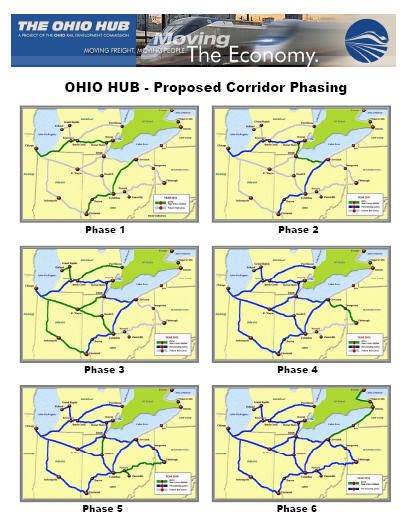 Today's Sunday Train is focusing on attacks that have been launched against Ohio's 3C plan (
Today's Sunday Train is focusing on attacks that have been launched against Ohio's 3C plan (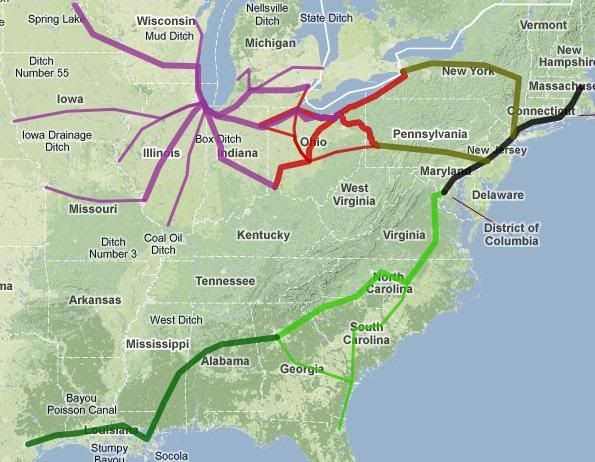 I have written now and again about the Ohio Hub project, sometimes in more length and sometimes less. Above the fold is the original six-stage plan, though if you squint you will see that the first stage could have started running later this year ... as with many of these plans, there was been a lot more planning than ground breaking in the previous decades, given the aggressively anti-rail Bush administration (and certainly expected under an administration that would have sold its soul to the oil companies if it had had a soul to sell).
I have written now and again about the Ohio Hub project, sometimes in more length and sometimes less. Above the fold is the original six-stage plan, though if you squint you will see that the first stage could have started running later this year ... as with many of these plans, there was been a lot more planning than ground breaking in the previous decades, given the aggressively anti-rail Bush administration (and certainly expected under an administration that would have sold its soul to the oil companies if it had had a soul to sell).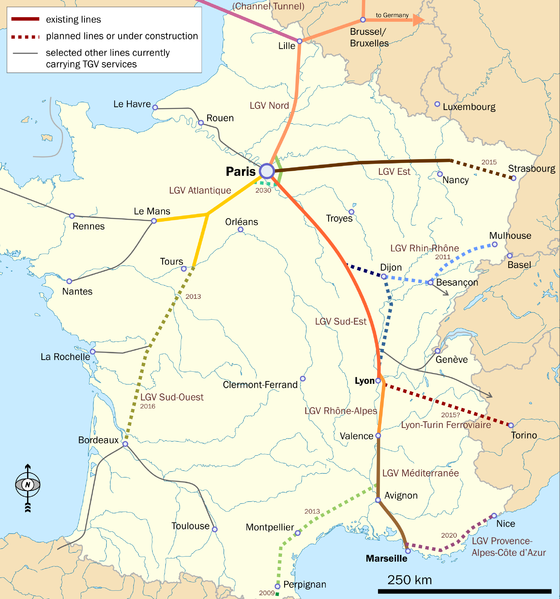 Of course, since France already had an Express Interurban network running substantially faster than Amtrak speeds, once the first segment of the HSR corridor was completed, the France completed the journey to Lyon on the existing express interurban corridor. Then completing an additional segment allowed more of the route to be operated at high speed, and so on until it was finished.
Of course, since France already had an Express Interurban network running substantially faster than Amtrak speeds, once the first segment of the HSR corridor was completed, the France completed the journey to Lyon on the existing express interurban corridor. Then completing an additional segment allowed more of the route to be operated at high speed, and so on until it was finished.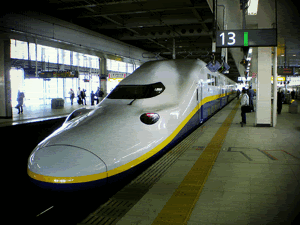 But for all the hype surrounding the president’s announcement, this exciting new mode of transportation won’t be arriving in America anytime soon unless the Obama administration and Congress make some "course corrections." The crux of the problem is that the administration has begun a major civic work without laying down engineering and design protocols that match the standards of fast train lines built elsewhere in the world. Even worse, the distribution of funds from the stimulus package ensures that the most promising projects will remain underfunded.
But for all the hype surrounding the president’s announcement, this exciting new mode of transportation won’t be arriving in America anytime soon unless the Obama administration and Congress make some "course corrections." The crux of the problem is that the administration has begun a major civic work without laying down engineering and design protocols that match the standards of fast train lines built elsewhere in the world. Even worse, the distribution of funds from the stimulus package ensures that the most promising projects will remain underfunded. And as I mentioned, then there are those who fall so thoroughly for Republican talking points, hook line and sinker, that one must wonder whether they really are that gullible or whether they are Republican operatives in disguise. "Ohiobama", for example.
And as I mentioned, then there are those who fall so thoroughly for Republican talking points, hook line and sinker, that one must wonder whether they really are that gullible or whether they are Republican operatives in disguise. "Ohiobama", for example. 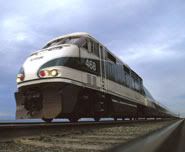 I've been like a hare chased by a hound this weekend, darting this way and that, so while I've got a lot of topics I could be writing on, I've got nothing coherent for a full fledged diary. So this week will be bits and pieces and this and that.
I've been like a hare chased by a hound this weekend, darting this way and that, so while I've got a lot of topics I could be writing on, I've got nothing coherent for a full fledged diary. So this week will be bits and pieces and this and that. Disclaimer: Nothing said here should be taken to imply that airport/train connections are the primary transport task for either light rail, mass transit, conventional intercity rail, or high speed intercity rail. In other words, the focus of an essay in a regular weekly series on one particular topic does not imply anything along the lines of "most important thing".
Disclaimer: Nothing said here should be taken to imply that airport/train connections are the primary transport task for either light rail, mass transit, conventional intercity rail, or high speed intercity rail. In other words, the focus of an essay in a regular weekly series on one particular topic does not imply anything along the lines of "most important thing".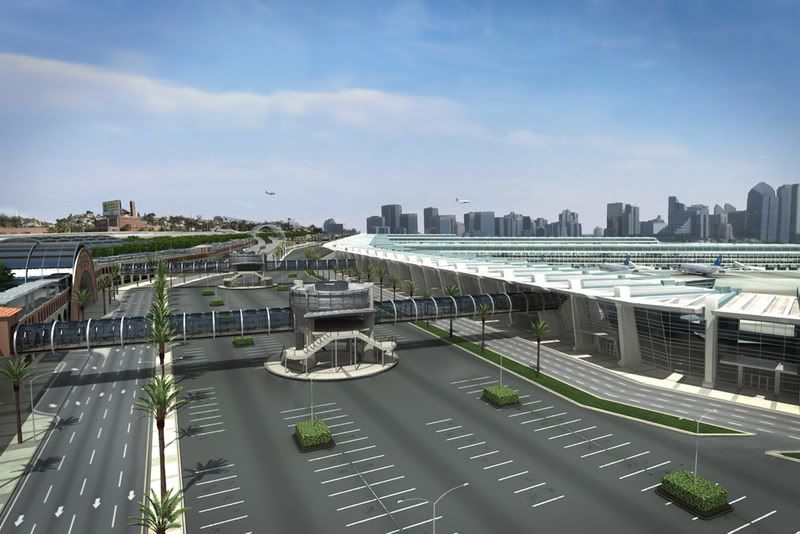 While the ITC is a very interesting proposal in terms of providing direct Trolley, Coaster and Amtrak Pacific Surfliner stops at the airport - Lindbergh Field is between one and two miles from downtown, and the existing Amtrak Pacific Surfliner terminus at Santa Fe is a much stronger location for the downtown San Diego HSR station. It is located on one Trolley line that runs to the border, adjcent to the trolley line to Petco field as well as one of the main downtown bus transfer centers. It is much more convenient to the Convention center and two blocks from the Coronado ferry.
While the ITC is a very interesting proposal in terms of providing direct Trolley, Coaster and Amtrak Pacific Surfliner stops at the airport - Lindbergh Field is between one and two miles from downtown, and the existing Amtrak Pacific Surfliner terminus at Santa Fe is a much stronger location for the downtown San Diego HSR station. It is located on one Trolley line that runs to the border, adjcent to the trolley line to Petco field as well as one of the main downtown bus transfer centers. It is much more convenient to the Convention center and two blocks from the Coronado ferry.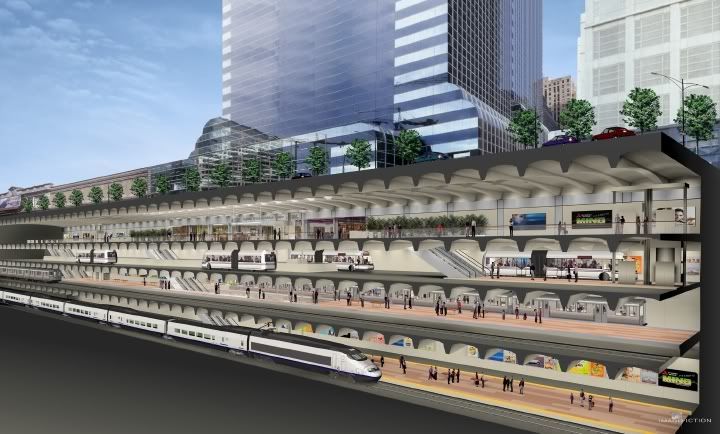 And of course, the reason that the Midwest Hub and Ohio Hub systems can be built out so much more quickly with so many more miles per dollar than the California HSR system is because they are starting out as 110mph Emerging HSR systems, built in existing rail corridors. So they stand to inherit the east/west divide.
And of course, the reason that the Midwest Hub and Ohio Hub systems can be built out so much more quickly with so many more miles per dollar than the California HSR system is because they are starting out as 110mph Emerging HSR systems, built in existing rail corridors. So they stand to inherit the east/west divide. Huh, seems me that whatever the state of my various concerns, the agenda of the Sunday Train has been taken over by the White House ... funny how announcing the recipients of a total of $8b will do that.
Huh, seems me that whatever the state of my various concerns, the agenda of the Sunday Train has been taken over by the White House ... funny how announcing the recipients of a total of $8b will do that.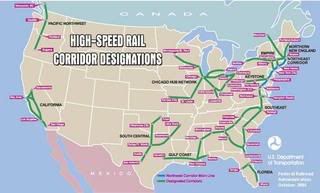 California, $2,344m. This includes $1,850m for the California HSR Stage 1 from San Francisco to Anaheim via San Jose, Fresno, Bakersfield, and the LA Basin. This is, in essence, enough to prime the pump for the California project.
California, $2,344m. This includes $1,850m for the California HSR Stage 1 from San Francisco to Anaheim via San Jose, Fresno, Bakersfield, and the LA Basin. This is, in essence, enough to prime the pump for the California project.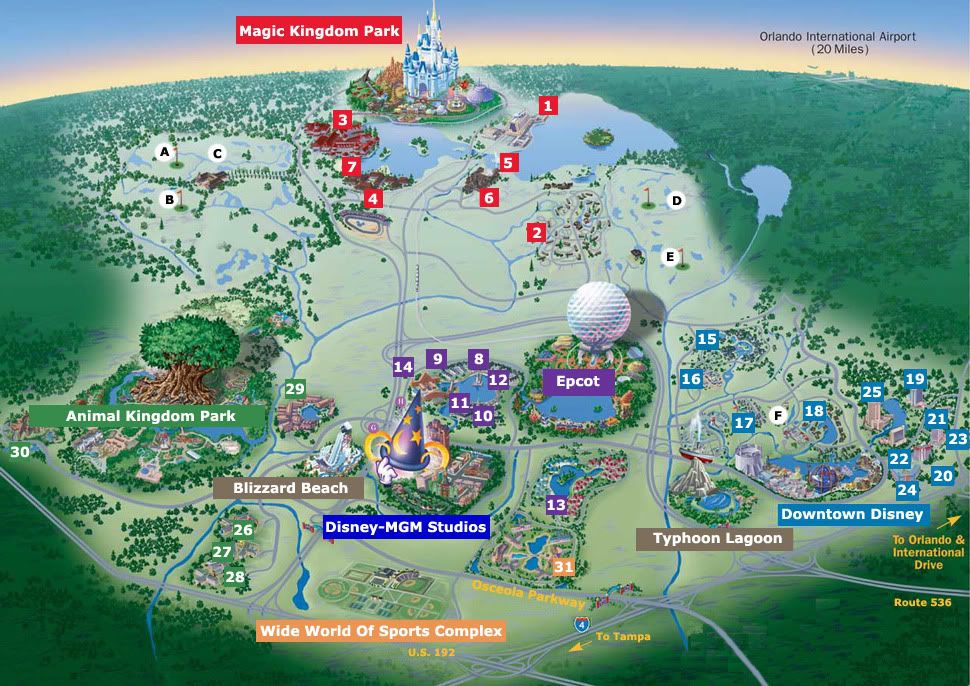 Florida: $1,250m. This is entirely for Express HSR track from Tampa to Orlando. This is a line that has been criticized for not connecting the two downtowns of the two cities. On the other hand, it does go to Disneyworld, and as an on-again, off-again project that kept getting squashed by lack of local funding, the Florida State Legislature was led to believe that their hopes of HSR funding required a commitment to support complementary local rail service. Support for SunRail passed, and so Florida got their Disneyworld train.
Florida: $1,250m. This is entirely for Express HSR track from Tampa to Orlando. This is a line that has been criticized for not connecting the two downtowns of the two cities. On the other hand, it does go to Disneyworld, and as an on-again, off-again project that kept getting squashed by lack of local funding, the Florida State Legislature was led to believe that their hopes of HSR funding required a commitment to support complementary local rail service. Support for SunRail passed, and so Florida got their Disneyworld train.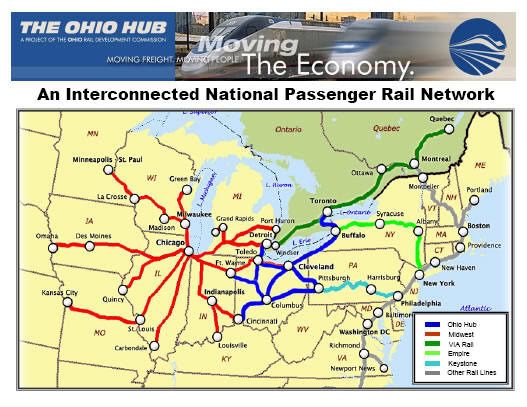 Illinois: $1,236m. The main project here is $1,102m to upgrade parts of the Chicago / St. Louis corridor to 110mph service, cutting end-to-end travel time to four hours, and bringing substantial new populations along the corridor within three hours or less of either Chicago or St. Louis or both. Further improvement of this corridor on the same basis can bring the end-to-end time down to three hours.
Illinois: $1,236m. The main project here is $1,102m to upgrade parts of the Chicago / St. Louis corridor to 110mph service, cutting end-to-end travel time to four hours, and bringing substantial new populations along the corridor within three hours or less of either Chicago or St. Louis or both. Further improvement of this corridor on the same basis can bring the end-to-end time down to three hours. In terms of HSR, establishing this service is a starter on establishing the 110mph version of the Triple C, which with two hour services to Columbus from either end is when the corridor is projected to be capable of generating a substantial operating surplus. It may take a series of upgrades, to get there, but each upgrade will cut trip speeds and improve patronage on the corridor, trimming the required subsidy until it finally goes away.
In terms of HSR, establishing this service is a starter on establishing the 110mph version of the Triple C, which with two hour services to Columbus from either end is when the corridor is projected to be capable of generating a substantial operating surplus. It may take a series of upgrades, to get there, but each upgrade will cut trip speeds and improve patronage on the corridor, trimming the required subsidy until it finally goes away.
